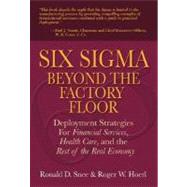"This book dispels the myth that Six Sigma is limited to the manufacturing process by providing compelling examples of transactional successes combined with a guide to practical deployment."
–Paul J. Norris, Chairman and Chief Executive Officer, W. R. Grace & Co.
"Ronald D. Snee and Roger W. Hoerl provide a compelling, fact-based, example-supported argument on the importance of improvement of nonmanufacturing processes within a manufacturing company. This valuable book completes the authors' "trilogy" of books on improving business performance via statistical thinking and Six Sigma, and is a welcome addition to the library of any individual or company engaged in this pursuit of excellence."
–Dr. Steven P. Bailey, principal consultant and Master Black Belt, DuPont Engineering, Past President American Society for Quality
"As interest in Six Sigma continues to flourish, this book will be of interest to newcomers and veterans alike. Snee and Hoerl address the case for Six Sigma, ensuring successful deployment and project success through a detailed yet easily understood style. Their use of case studies rounds out their assertion that Six Sigma can and should be used to improve performance in all types of businesses, from finance to health care."
–Jean Cherry, Executive Vice-President, Commonwealth Health Corporation
The first comprehensive, step-by-step Six Sigma implementation guide for nonmanufacturing organizations
- For finance, health care, retail, logistics/supply chains, R&D, education, nonprofits... every nonmanufacturing organization and function
- Expert deployment planning strategies, proven execution tactics
- Statistical methods, tools, and best practices–customized for nonmanufacturing organizations
- Something for every Six Sigma implementer–from beginners to leaders, champions, green belts, black belts, and master black belts
- Coauthored by Roger W. Hoerl, a leader in implementing Six Sigma at GE, including in corporate finance
Nonmanufacturing organizations are rapidly discovering Six Sigma's immense potential to reduce costs, improve performance, grow revenue, strengthen focus, and empower people. To achieve these results in your organization, start right here.
Drawing on new case studies, renowned practitioners Ron Snee and Roger Hoerl cover up-front planning and strategy... team building and executive sponsorship... project execution... methods, statistical tools, and metrics... overcoming obstacles... and much more. Their advice and best practices can guide you through any stage of the process, whether you're just starting out or extending an existing initiative. With their help, scores of world-class enterprises have delivered on the promise of Six Sigma. With this book, you can, too.
Dr. Ronald D. Snee is principal in Tunnell Consulting's Performance Excellence Practice, which offers Six Sigma consulting, training, facilitation, and implementation, in addition to other process improvement approaches. Dr. Snee is a winner of the American Society for Quality's highest honor, the Shewhart Medal, and has served as a member of the Malcolm Baldrige National Quality Award Criteria Team. He designed DuPont's first company-wide continuous improvement curriculum.
Dr. Roger W. Hoerl is a long-time leader of GE's renowned Six Sigma initiative. As manager of GE's Applied Statistics Lab, he partners on R&D with GE businesses ranging from NBC and GE Capital to GE Aircraft Engines. He has implemented Six Sigma in a wide range of GE processes, ranging from corporate audit to delinquent credit card tracking. He recently won the American Society of Quality's 2002 Brumbaugh Award.
Snee and Hoerl are coauthors of Leading Six Sigma (Financial Times-Prentice Hall, 2003), the best-selling executive's guide to Six Sigma. They also cowrote Statistical Thinking: Improving Business Performance (Duxbury Thomson Learning, 2002), an innovative guide to the strategic use of data and statistics in solving business problems.
There are dozens of books on implementing Six Sigma in manufacturing. But what if you're in finance? Or health care? Or e-commerce? Or supply chain management? Or R&D? Or the nonprofit sector? This book focuses on your needs: Six Sigma Beyond the Factory Floor, the start-to-finish Six Sigma guide for the rest of the real economy.
Ronald D. Snee and Roger W. Hoerl cover every level of Six Sigma implementation in nonmanufacturing environments: deployment planning and strategy, project execution, methods, statistical tools, and more. Throughout, they illuminate key concepts with case studies from a wide range of businesses and functions. Drawing on their unsurpassed consulting experience, they systematically identify hurdles to success–and best practices for overcoming them.
Whatever your Six Sigma goals, this book will help you achieve them faster–with less pain, cost, or risk.
- Using a proven Six Sigma deployment roadmap for nonmanufacturing organizations
- Planning strategies, execution tactics, customized methods and tools
- Leveraging the immense value of Six Sigma in your environment
- Realistically assessing the benefits of Six Sigma in nonmanufacturing organizations
- Driving ongoing success: lessons from real-world case studies
- Best practices for driving project-by-project improvement
- Aligning the entire organization behind Six Sigma
- From leadership commitment to team building–and beyond








